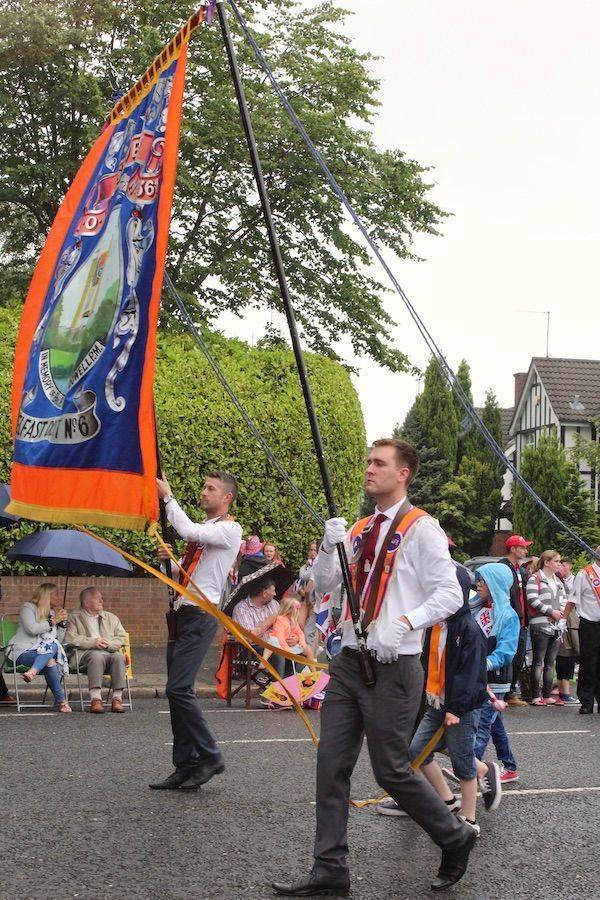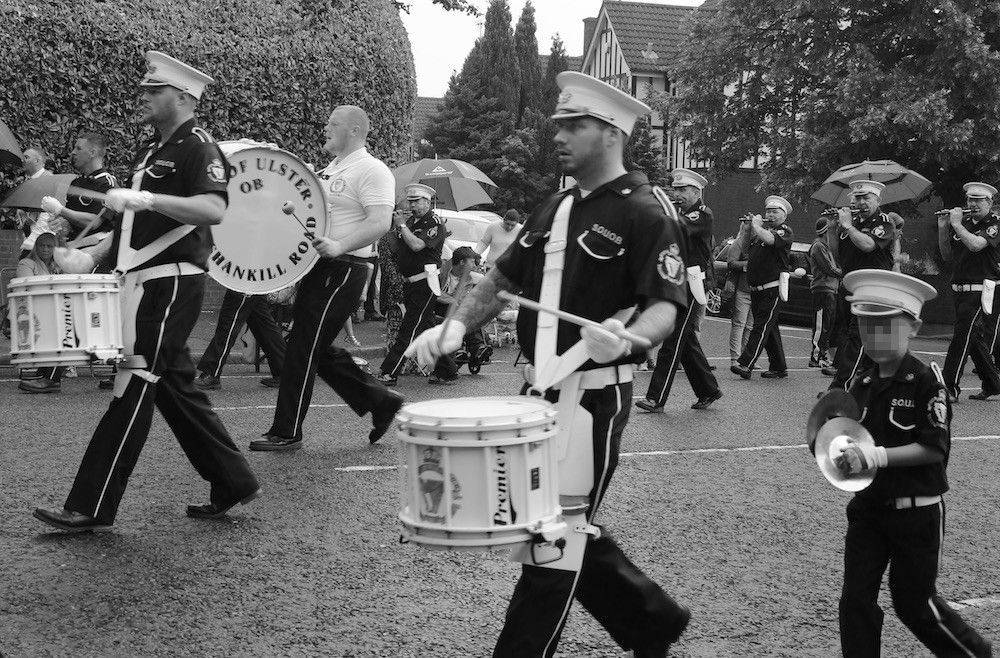In 2015, an MI5 report revealed that all the main paramilitary forces active during The Troubles were still intact, and some of their weapons had yet to be decommissioned. Even if the reports claimed that a return to widespread violence was unlikely, the massive presence of weapons proves the salience of sectarianism. Particularly, the New IRA, an amalgam of dissent groups like Republican Action Against Drugs, the Real IRA and various independents, has engaged in the last years in a series of violent attacks in the name of achieving a 32-county socialist Irish Republic with no interference from Britain. This dissident group is reportedly exploiting the discontent in the country to rally new recruits; moreover, Saoradh, the Irish Revolutionary Republican Socialist Party, even though not officially, seems to be heavily linked with the paramilitary activities of the New IRA.
The not-so-metaphorical resort to “guerrilla warfare” against the Northern Ireland Protocol threatened by DUP’s Sammy Wilson, and the refusal of the Sinn Féin to meet Boris Johnson on March 12 show how tensions can escalate quickly. Starting from last week, the Unionist community has been protesting against the authorities’ decision not to prosecute members of the Sinn Féin for their attendance in June 2020 at the funeral of Bobby Storey, senior Sinn Féin member and intelligence chief of the IRA, in violation of Covid-19 restrictions. Clashes are spreading beyond Derry and Belfast as Loyalist demonstrations resort to violence: over 50 police officers have reportedly been injured. These events come after months of violent rhetoric from Loyalist representatives regarding the post-Brexit arrangements.

In this situation, it is necessary to emphasise the steady shifts of Northern Ireland demographics: a census to be conducted soon is expected to return a majority of cultural Catholics (Catholics by belief or family origin). It is not by chance that in the parliamentary elections of December 2019 Nationalist representatives outnumbered Unionists for the first time in 100 years. At this point in history, a discussion on the future of a possible unified Ireland is inevitable, considering that there may be the electoral and referendum majority (50 percent plus one) for a change of sovereignty status of Northern Ireland. Furthermore, while 90 percent of the self-described Nationalists voted “Remain” in 2016, the number of Unionists voting “Leave” only reached 66 percent. A poll by Lucid Talk of 2018 revealed that two-thirds of respondents had not changed their mind on the constitutional position of Northern Ireland; however, those who did were for the most part ex-supporters of Unionism who would have voted in favour of Northern Ireland joining the Republic of Ireland. The Next Generation Ireland/Northern Ireland report of 2018 exposed young people’s distrust in political institutions, however the youngest generation of the Republic of Ireland was more optimistic about the country’s future (53 percent of respondents), compared to a mere 20 percent among Northern Ireland’s youth. At the same time, the Irish general elections of February 2020 celebrated a historic result for Sinn Féin, the party that was pushing for a referendum on reunification to be held by 2025.
One important actor in this phase is the Irish community in the US. In response to the UK’s unilateral decision to extend the grace period given to supermarkets in Great Britain exporting agri-foods to Northern Ireland, Friends of Sinn Féin USA has organised a media blitz by placing advertisements in the New York Times, Washington Post and other newspapers in support of Irish reunification. The motto “A united Ireland – let the people have their say” is even more meaningful considering that the Taoiseach (Ireland’s Prime Minister) Micheál Martin and the US President Joe Biden met virtually on St Patrick’s Day. Biden remarked on the US’s unwavering support for the Good Friday Agreement.
Everything seems to point to a possible referendum in the near future. The escalation of violence needs to be avoided at all costs, which means that dialogue and rules for a well-structured and pacific reunification need to be delineated as soon as possible. If malcontent is not listened to, it is possible that when the restrictions imposed by Covid-19 ease, riots will get out of control: current disorders should be a weak-up call; in these circumstances, the DUP’s flirts with paramilitary groups are a dangerous precedent. As stated by Michelle O’Neill, Sinn Féin’s vice president and Deputy First Minister of Northern Ireland, a discussion on the referendum needs to be respectful, inclusive and informed.
Meanwhile, the ideas of Loyalism and Nationalism are very much alive. Researchers warn that kids are instilled with a sectarian mindset starting from an early age. 51 percent of children can recognise at least one sectarian symbol by the age of three; by the age of six, 90 percent of them are aware of sectarian divisions and 33 percent identify with a specific group. When they turn ten, children talk about the other group based on prejudices and stereotypes. Despite widespread public support for integration, less than 10 percent of Northern Irish students attend religiously integrated schools; at the same time, “peace walls” continue to divide Catholic and Protestant neighbourhoods all around Northern Ireland, above all in Belfast. Wednesday night, petrol bombs and missiles were thrown at the Lanark Way peace wall gates in west Belfast. It is evident that long-standing frictions within civil society have hardly weakened. Frequent parades organised mainly by Protestants still make use of sectarian flags, emblems, symbols, songs. 13- and 14-year-olds were arrested among Loyalist rioters that attacked police officers in Derry and Belfast last Friday; the vast majority of those who are taking part in the violent protests are under the age of 18. Sinn Féin’s Paul Maskey blames DUP’s rhetoric for the growing anger within Loyalists around post-Brexit arrangements: “It is always sad to see young people being used by sinister elements to advance their regressive agenda.”
Even so, there is no desire for violence among common people: while The Troubles are romanticised abroad, mainly among the Irish American diaspora, they still represent a dark, unforgotten past for Northern Irish people. The disappointment of young people with Westminster is palpable: the words of Jason Feenan, drummer of the punk band Touts, are well-known in Derry, where the Brexit negotiation is perceived as “a decision made in England, and we’re just dragged along with it.” Nevertheless, Belfast District Commander Chief Superintendent Simon Walls stresses that “local communities do not want to be dragged back to the past. They deserve to live in safe and peaceful areas, free from rioting, violence and wanton destruction of their communities.” The motto FAP (Fuck all Paramilitaries), common among several groups of the Northern Irish youth, gives an idea of how the resort to guerrilla warfare may seem completely backwards in the eyes of new generations. Echoing the words of Michelle O’Neill, the United Ireland “has to be one where those who have an Irish identity and those who have a British identity feel part and parcel, feel that they have their place, and it’s valued and cherished.”
This is exactly why the role of civil society needs to be preserved, particularly the role of social movements which do not identify with Protestant Unionists or Catholic Nationalists. Class-based networks, for example, have brought together workers of antagonistic ethno-nationalist groups in the name of common interest, facilitating in some cases coexistence between the two communities. During the May Day parade in Belfast, nonsectarian trade unionists march together embracing their diversity and celebrating memories of cross-community solidarity; they clearly want to distance themselves from Unionist and Nationalist annual celebrations, aimed at commemorating conflicts and reinvigorating divisions. Civil society organisations have been the glue holding Northern Ireland together: while Stormont (the Irish Parliament) has always struggled with the promotion of social rights, nonsectarian networks have been crucial in shaping policies. Their sensitive role has to be preserved in the post-Brexit phase at all costs.
The governments of Dublin and London need to start thinking about the fact that Northern Ireland may leave the UK in the near future. They have to be ready for the transition if, or when, the time comes. The wishful slogan “we can be the first generation of Americans to visit a free and United Ireland”, that has been circulating among US newspapers is now more topical than ever.
[ go back to part 1 of this report ]
Cover photo: (C) Ilaria Briglia. Belfast, “The Twelfth” or "Orangemen’s Day” parade, 13 July 2015.
